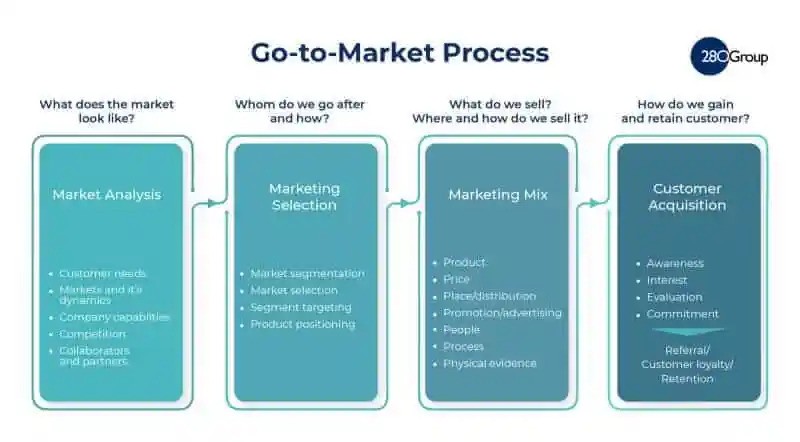
Go-to-market strategy is the approach and plans you use to succeed in the market and ensure your product is as successful as possible both short-term and long-term. Taking a product to market has a lot of moving parts, think of the go-to-market strategy as the marketing perspective you need to support your product throughout the seven-phase Product Lifecycle.
What is a Go-to-Market Strategy?
Go-to-market strategy is the approach and plan you use to succeed in the market and ensure your product is as successful as possible both short-term and long-term. Think of the go-to-market strategy as the marketing perspective you need to support your product throughout the seven-phase Product Lifecycle. A go-to-market strategy template makes sure you have all the components in place to, well, get your product to market.
Taking a product to market has a lot of moving parts. The go-to-market process has four key parts:
Go-to-market strategy components
- Market Analysis – What does the market look like?
- Market Selection – Whom do we go after and how?
- Marketing Mix – What do we sell? Where do we sell it? What is the price?
- Customer Acquisition and Retention – How do we sell it? How do we gain and retain customers?
To answer the questions on the right, we use Product Management skills such as:
- Market Segmentation
- Product Differentiation
- Market Research and Competitive Analysis
- Product Pricing Strategies

If you have no background in marketing, you’ll want to start by researching the topics in Product Manager Skills: Marketing Speak.
Grasping the Importance of a Go-To-Market Strategy
In our practice, 280 Group consults with many organizations. Most of them wait too long to develop their market strategy. The go-to-market strategy is an afterthought either as the product is heading off to be developed or, worse, just as it’s being completed. Developing your market strategy early in the Product Lifecycle at the plan stage can dramatically increase your product’s chances of success.
Go-To-Market Strategy – Product Manager or Product Marketing Manager?
If your organization splits the role of Product Management and Product Marketing, the go-to-market strategy often is the responsibility of the Product Marketing Manager. If you don’t have direct responsibility for developing the go-to-market strategy, you’ll still be a key contributor to the contents. No matter who completes the go-to-market strategy template, make sure that sales is involved. They have key insights that will definitely make market acceptance of your product more likely.
Product Managers, Product Marketing Managers and Product Owners work with a wide variety of people and departments collectively known as Stakeholders. Here is a description of the most important of these stakeholders and how Product Management helps them achieve their goals.
What is Product Management’s Relationship To Other Groups and Key Stakeholders?
Voila – The Go-To-Market Template
When you’ve collected the information, the next step is to document your go-to-market strategy so that you can get agreement from all parts of the organization. This table lists the key elements of the go-to-market strategy document. In addition to these sections, you also fill in the risks, assumptions, and open issues.
- Executive summary – A summary of the entire market strategy.
- Whole product offer – What is the whole product offer? Which components of the actual product and augmented product are most critical?
- Pricing – What is the proposed price of the product? What is the strategy and rationale for setting this price? If it’s too far in advance, do any pricing boundary conditions need to be met, such as margin or cost? What happens if these boundary conditions aren’t met?
- Segmentation – Which are the target market segments that the product addresses? Why are these segments the best fit for your product or solution?
- Positioning – What is the overall product positioning? Are there additional positions for channel partners?
- Messaging – On the basis of the positioning, what are the key messages? If you don’t have all the proof points, put in what you have now and build on it in subsequent versions.
- Strategy – What is your strategy for taking this product to market? In what way are you the leader? And how does this strategy align with your company’s overall strategy and market position?
- Launch Programs – What are your top-line launch programs and initiatives? What are the key launch milestones?
- Budget – How much is the likely cost to successfully bring the product to market? This figure isn’t product development cost; it’s the marketing and sales costs.
- Conclusion & Recommendation – Based on the rest of the go-to market strategy document, what is your conclusion and recommendation?
Congratulations on making a go-to-market strategy part of bringing your product to market. Your chances of success just increased.


